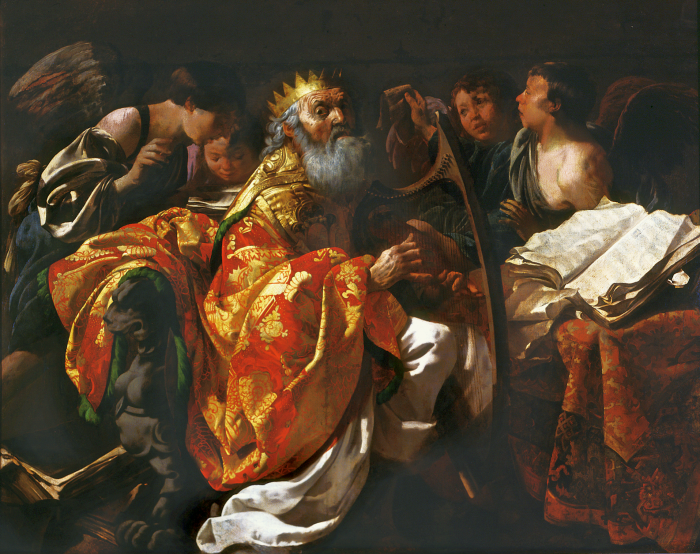‘He Must Reign’: The Kingdom of God in Scripture
Lesson Six: ‘The Key of David’: Church and Kingdom in the New Testament

Lesson Objectives
- To understand the characteristics and identity of the kingdom of God as it is portrayed in the New Testament epistles and the Book of Revelation.
- To see how the Church is identified with the kingdom in the New Testament.
- To understand how the Church, as it is portrayed in the New Testament, bears the characteristics of the Davidic kingdom.
II. The Covenants of Promise
A. The First-Born
We find a further association of kingdom and Church in the family imagery used to describe the New Testament community. This imagery shows the early Church seeing deep ties between the covenants of Israel’s salvation history and the sacraments of the Church.
Jesus is described frequently as God’s "first born" (see Luke 2:7; Romans 8:29; Colossians 1:15,18) - a designation that evokes a key theme in God’s relationship with Israel.
God named Israel His first-born son among the nations (see Exodus 4:22; Deuteronomy 32:6; Hosea 11:1; Sirach 36:11).
This "primogeniture" was closely related to Israel’s covenant mission as a "kingdom of priests" (see Exodus 19:6) - to be mediators of the knowledge and true worship of the living God to its "brother" nations.
In His covenant with David, God deepened this identification of Israel’s first-born and priestly stature and its mission to reign over all nations - swearing that David’s son would be His son, "the first-born, the highest of the kings of the earth," and a "priest forever" (see2 Samuel 7:12-14; Psalm 2:7; 89:27-29; 110:4; John 7:42).
In the New Testament, these promises are directly applied to Jesus (see Hebrews 1:5-6;7:21; Revelation 1:5). Jesus, through His death and resurrection, becomes "the firstborn" of "many children" (see Romans 8:29; Hebrews 2:10-13).
The kingdom is frequently described in the New Testament epistles as an "inheritance" (see Ephesians 5:5; 1 Corinthians 6:9-10; 15:20; Galatians 5:21; Colossians 1:12). This inheritance is claimed through faith in the gospel, a faith that finds expression in the sacrament of baptism.
In the only use of "kingdom" language in John’s gospel, Jesus tells Nicodemus that entry into the kingdom of God means being begotten by water and the Spirit (see John 3:3,5).
Baptism is how one enters the kingdom and how one enters the Church. Again we see a presumption of the near identity of Church and kingdom.
Through baptism, believers come to share in the national history of Israel, which is also the history of salvation. They become "sharers in the covenants of promise" that God made to Israel (see Ephesians 2:12).
In particular, they become heirs to the family of God, according to the promise made to Abraham - that through Abraham’s descendants all the nations of the world would be blessed (see Romans 8:17; Galatians 3:29)
As we looked at in detail in our first lesson, all of Israel’s history, including the exodus from Egypt, the covenant made at Sinai, and the establishment of the monarchy under David, can be seen as partial fulfillments of God’s covenant with Abraham.
The ultimate fulfillment of that covenant comes in the blood of Jesus, by which believers are made "children of Abraham" (see Galatians 3:7-9) and "children of God" through the working of the Holy Spirit (see Galatians 3:26; 4:6-7).
The kingdom, then, is understood in a certain sense as a family of God, in which believers are called to conduct themselves worthily as God’s children (see 1 Thessalonians 2:12).
B. Kingdom of Priests
Here again, we see a tight connection between the early Christian notions of Church and kingdom. The Church, made up of royal sons and daughters of God, Jewish and Gentile, is the new, and true Israel of God (see Galatians 6:16).
In this, the Church fulfills the original commission and identity given to Israel in the covenant at Sinai. There, God established Israel as a "kingdom of priests, a holy nation" (see Exodus 19:6).
The New Testament writings apply this description of Israel as a priestly kingdom to the Church (see 1 Peter 2:5-10), in which members share in the priesthood and sonship of Christ (see Revelation 1:5-6).
In Revelation’s vision of the scroll and the lamb, Christ is celebrated as purchasing with His blood "a kingdom and priests for our God, and they will reign on earth" (see Revelation 5:10).
Significantly, this kingdom is made up of people, not only from Israel, but from "every tribe and tongue, people and nation" (see Revelation 5:9).
The vision itself is filled with images from the exodus and from Daniel’s vision of the son of man. As Daniel’s son of man receives authority over peoples and nations of every tongue or language, so does the kingdom of priests, the Church, in Revelation (compare Daniel 7:14; Revelation 5:9).
As the son of man receives glory and honor in Daniel’s vision, so does the Lamb in Revelation (compare Daniel 7:13-14; Revelation 5:12). And as the holy ones of the Most High possessed the kingdom in Daniel, the kingdom of priests in Revelation is said to reign on earth (compare Daniel 7:22).
Daniel’s vision evoked the original calling and purpose of Israel. And so does John’s vision of the Lamb.
In this vision we have a summary of the New Testament understanding: The Church - the restored kingdom of David that encompasses the twelve tribes of Israel and all the Gentile nations - fulfills the prophecy of Daniel and is the heir and successor to the promises of Israel.
Other Lessons
- Lesson One: A Throne Established Forever
- To begin to appreciate the significance of God’s covenant with David for understanding the content and meaning of the New Testament.
- To understand the biblical idea of the monarchy and the Old Testament background for the Davidic covenant.
- To understand the basic outlines of the promises made to David and the shape of the Davidic kingdom under both David and Solomon.
- Lesson Two: Looking for the ‘New David’
- To understand the basic outline of Israel’s history in the centuries between the collapse of the Davidic kingdom and the beginning of the New Testament era.
- To appreciate how the collapse and disappearance of the Davidic Kingdom shaped Israel’s hopes and beliefs in the five centuries before Christ.
- To understand how God’s covenant promises were interpreted by Israel’s prophets and how those prophecies were understood in the last centuries before Christ.
- Lesson Three: The Son of David in Matthew’s Gospel
- To understand the symbolism Matthew uses to convey the truth that Jesus Christ is the perfect Son of David.
- To see how the baptism of Jesus corresponds to the anointing of the Davidic kings.
- To understand how Matthew sees Jesus’ kingdom as the fulfillment of the promises in the prophets.
- Lesson Four: The Throne of David, His Father
- To see how Luke emphasizes Jesus’ lineage as Son of David in the infancy narrative.
- To see how Jesus appears in public as the Son of David throughout Luke’s Gospel.
- To understand how, at the climax of Luke’s Gospel, Jesus takes his place as heir to the kingdom of David.
- Lesson Five: The Spread of the Kingdom in Acts
- To understand how Jesus’ parting words to His disciples form a map of the ideal Davidic kingdom.
- To see how the structure of the Acts of the Apostles follows that map.
- To see how Luke paints the nascent Church as the Davidic kingdom perfectly restored.

